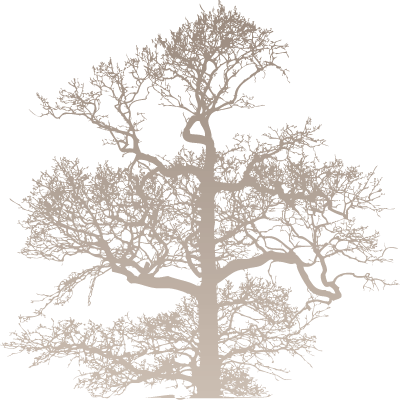Byzantine Catholic
Binghamton, Broome County, New York
Yonkers, Westchester County, New York
Orthodox
Corning, Steuben County, New York
Byzantine Catholic
Holy Spirit Byzantine Catholic Church
Binghamton, Broome County, New York
TCC wishes to extend a special thank you to Father Peter Tomas and Pani Michelle Tomas.
History
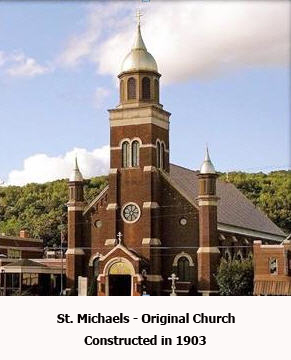 Holy Spirit Greek (Byzantine) Catholic Church was originally organized in 1903. It was named Saint Michael’s Greek Catholic Church and was located at 296 Clinton Street in Binghamton. However, by 1936 an unfortunate division occurred within the parish. Some members wanted to convert to the Orthodox faith while others desired to remain Greek Catholic. By 1936 problems escalated. Litigation over church ownership was not settled until 1939. Those who converted to the Orthodox Church joined the American Carpatho-Russian Orthodox Church Diocese. This segment of the congregation was given possession of the church and property. The pastor of Saint Michael’s, the Reverend Michael Staurovsky and his parishioners, were determined to remain Greek Catholic. After the court decision, Father Michael and his parishioners were allowed to hold services at St. Joseph’s Lithuanian Catholic Church on Judson Avenue in Binghamton. Saint Joseph’s had been in existence since 1914 and graciously offered their church so Greek Catholic services would continue. Father Michael and his parishioners were not discouraged by the events that transpired. Instead of being down-cast at the loss of their church and property, they immediately set out to obtain a new church. The Mother’s Club was started in 1934 with the main function of assisting at church events. During World War II, these kind and dedicated women mailed numerous packages to servicemen. Even today, this tradition continues. Gifts are still sent to United States military personnel. The Mother’s Club of Holy Spirit Church is to be commended for their patriotism to those in the United States armed forces. During 1947 the Mother’s Club compiled their own cookbook. It is still in print and can be purchased from the church today. Numerous copies have been mailed all over the United States and even to other countries. The income derived from the sale of this cookbook is collected and utilized for various church needs.
Holy Spirit Greek (Byzantine) Catholic Church was originally organized in 1903. It was named Saint Michael’s Greek Catholic Church and was located at 296 Clinton Street in Binghamton. However, by 1936 an unfortunate division occurred within the parish. Some members wanted to convert to the Orthodox faith while others desired to remain Greek Catholic. By 1936 problems escalated. Litigation over church ownership was not settled until 1939. Those who converted to the Orthodox Church joined the American Carpatho-Russian Orthodox Church Diocese. This segment of the congregation was given possession of the church and property. The pastor of Saint Michael’s, the Reverend Michael Staurovsky and his parishioners, were determined to remain Greek Catholic. After the court decision, Father Michael and his parishioners were allowed to hold services at St. Joseph’s Lithuanian Catholic Church on Judson Avenue in Binghamton. Saint Joseph’s had been in existence since 1914 and graciously offered their church so Greek Catholic services would continue. Father Michael and his parishioners were not discouraged by the events that transpired. Instead of being down-cast at the loss of their church and property, they immediately set out to obtain a new church. The Mother’s Club was started in 1934 with the main function of assisting at church events. During World War II, these kind and dedicated women mailed numerous packages to servicemen. Even today, this tradition continues. Gifts are still sent to United States military personnel. The Mother’s Club of Holy Spirit Church is to be commended for their patriotism to those in the United States armed forces. During 1947 the Mother’s Club compiled their own cookbook. It is still in print and can be purchased from the church today. Numerous copies have been mailed all over the United States and even to other countries. The income derived from the sale of this cookbook is collected and utilized for various church needs.
By October of 1941, 32 acres of property were purchased. In 1941 Holy Spirit Church Holy Name Society was begun. The society was formed to assist the church with various services. To this day, the society still perform duties such as ushers and also continue the long tradition of standing guard on Good Friday throughout the night at the grave (Plaschanitza) of Christ. The Holy Name Society has continued to support Holy Spirit Church with fundraisers and offers many functions throughout the year. As time progressed another 65 acres of property were obtained in 1947. The second purchase of property was consecrated and dedicated for use as Holy Spirit cemetery. Other property had been purchased and the parcel at 360 Clinton Street, not far from their original church, was designated as the site for Holy Spirit. Construction of the new church began with a ground breaking ceremony and blessing service in 1950. Holy Spirit would be constructed of Indiana limestone and two majestic towers graced by two gold cupolas with three bar crosses. In the front of the church, above the entrance doors, is a breathtaking full-length stained glass window. When the sun gently rests upon the church, the blending of the limestone color, tiled roof and the golden cupolas are an impressive sight to behold. The church blueprints for construction followed Byzantine/Romanesque architecture while taking into account the surrounding landscape. After waiting so long to have their own house of worship, construction was 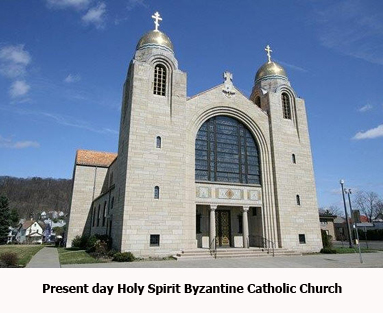 finalized and all interior decorations were completed. On Palm Sunday of 1952, the first Divine Liturgy was offered by Father Michael Staurovsky. This church, built because their own church had been lost, is a genuine testament of the devotion and love for the Byzantine Catholic faith of its members and clergy.
finalized and all interior decorations were completed. On Palm Sunday of 1952, the first Divine Liturgy was offered by Father Michael Staurovsky. This church, built because their own church had been lost, is a genuine testament of the devotion and love for the Byzantine Catholic faith of its members and clergy.
Holy Spirit church began to experience growth and their membership numbers increased. In 1959, a new rectory was built. By 1974 the Holy Spirit Center was constructed with a modern kitchen, auditorium and classrooms. These classrooms were vital as they were dedicated specifically for teaching religious instruction to the parish children. During 1987, the Mother’s Club also revised their name to the Mother’s Club/Guild. They are known is the area and beyond for their various baking endeavors. Every year, these hard working members bake numerous nut, apricot, lekvar, poppy seed rolls and Paska (Easter Bread). The income derived from these sales is of great benefit to the church which helps with financial obligations. During 1990 the church was updated and interior mosaics, paintings and stenciling were added to the church interior.
The church interior is elegant. A perfect balance of color graces the iconostasis and draws visual attention to the altar which is a work of art. Adorned in mosaic, it has a cross in red and green with the letters IC XC NI KA, which translate to “Jesus Christ Conquers.” A gold cross is graced on each side by two golden fans. Above the baldacchino is a mosaic icon of the “Mother of God of the Sign.” Under the baldacchino (right over the altar proper) is a stained glass masterpiece depicting the Holy Spirit. An oval area that surrounds the outside altar is adorned with icons of Christ, the Virgin and the Saints. All pillars are in green marble and three graceful chandeliers’ illuminate the interior. The tretapod is delicately adorned with an inlaid gold and blue three bar crucifix flanked by two standing vigil lights. The color scheme of green, light green, gold and light brown all escalate towards the ceiling which has painted stars on it.
Always mindful of their origins, in October of 2008, a Carpatho-Rusyn dancing group was formed. These young folk dancers have performed for many church functions and events. Ever mindful of following their Byzantine Catholic faith and performing works of love and compassion, they perform at a local nursing home for the enjoyment of many residents. At present, Holy Spirit Byzantine Catholic church is served by Father Peter Tomas and his family, Pani Michelle and their son Peter. Divine Liturgy is said on Saturday evenings at 4:30 p.m. and on Sunday mornings at 10 a.m. A church that is friendly and inviting, Holy Spirit is a parish filled with great love and devotion to the Byzantine Catholic faith and for all who worship here. This church is a permanent monument to those who persevered through many trials to build a new church. Holy Spirit Byzantine Catholic Church had a remarkable history, but, more important, has a future filled with an abundance of great promise. Guided by the traditions of the past and as they move forward with a strong focus into another decade, this church is as dynamic and welcoming as it was when first begun in 1903.
More photos are available for viewing in the Gallery Section
Visit their Facebook Page
Visit their Church Website
St. Nicholas of Myra Byzantine Catholic Church
Yonkers, Westchester County, New York
Photo Credit: soyosunset.yuku.com
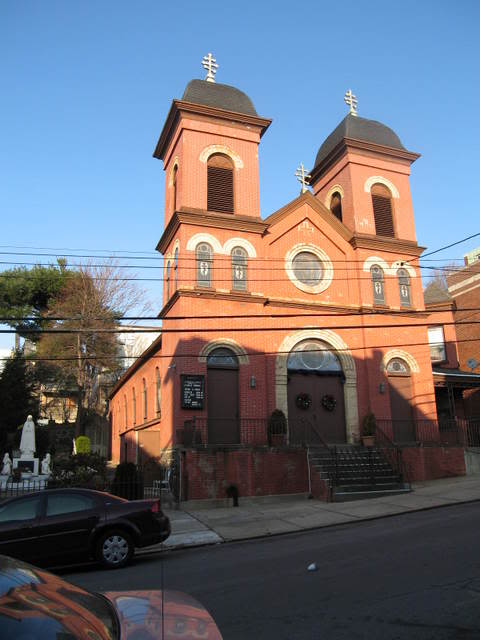
During the 1880’s immigrants arrived from the former Austro-Hungarian Empire and settled in Manhattan. Many of these immigrants moved further to the outlying areas surrounding New York City. These immigrants began to build churches so they could worship in their ancestral faith. In 1887, fifteen families began meeting at Public School Number 7 in Yonkers, New York. Some of the founders’ surnames were Debrocky, Hopko, Kostik, Hayduk and Nyahay. During these years, Father Alexander Sereghy from St. Elias Greek Catholic Church in Brooklyn offered services for the faithful. A building fund was established setting a donation of $10.00 from families and $5.00 for single individuals. Property was secured on Ash Street in Yonkers during 1891. The church was officially incorporated as the Hungarian Slavonic Greek-Catholic Church of Saint Nicholas of Myra.
Work started for the construction of the church with a number of parishioners offering their services as manual laborers. During this period the membership had grown to over forty families. At one point during excavation a serious problem developed. A massive rock was found in the rear of the property. This could only be resolved by blasting which was financially impossible for the newly formed church. After consultation it was decided to build a basement only as far as where the rock was located. On May 30, 1892, to the happiness of the parishioners, the corner stone for the church was blessed by the first pastor of Saint Nicholas, Father Eugene Szatala. On July 1, 1892, the construction was completed at a cost of $12,000.00.
Photo Credit: soyosunset.yuku.com
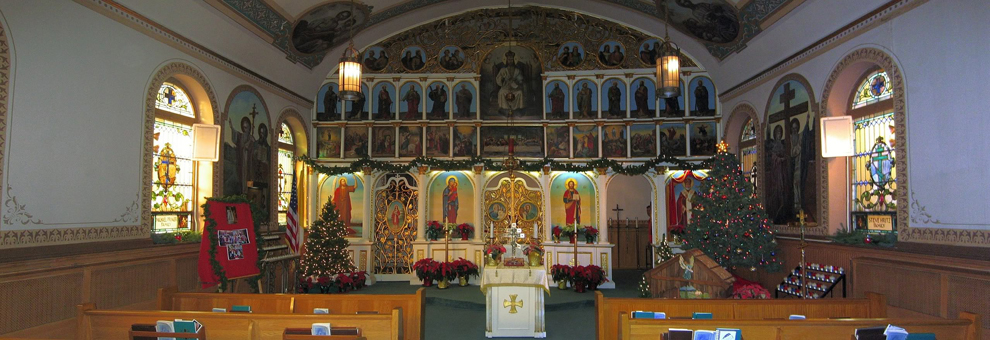
Saint Nicholas was the first and only Greek Catholic church in Yonkers and membership expanded rapidly. At this time there were only two Roman Catholic churches in Yonkers. Since they did not have priests who could serve those of the Roman Rite who only spoke Hungarian, Polish, Slovak or Ukrainian, these immigrants also attended Saint Nicholas. During 1898 pews, an iconostasis and beautiful stained glass windows were added. The parishioners donated generously time and time again to make their church beautiful and modern. A hot air heating system was installed, a new rectory purchased and the old rectory utilized for the full time cantor. During 1906 the church name was amended to the “Greek Catholic Church of Saint Nicholas of Myra.” From their humble beginnings, Saint Nicholas had expanded to become a beautiful house of worship which was the pride of faithful.
During 1922 Father Constantine Roskovics was installed as pastor. Father Constantine worked tirelessly with his parishioners and during his tenure all church debt was satisfied including a $9,000.00 mortgage. A banquet was held and Bishop Basil Takach was invited to witness the burning of the church mortgage. Also, due to the many fund raisers and donations of the faithful, the church had a surplus of $41,000.00 in savings during this period. In 1927, Father Basil Beretz was assigned as pastor and he would remain at Saint Nicholas for seventeen years. Later, due to his hard work and excellent administrative skills, he was appointed Very Reverend Dean of the Metropolitan Deanery. It is to the credit of Father Basil and his dedicated parishioners that at the height of the depression, a $12,000.00 interior remodeling project was completed. New pews, flooring, full interior painting, a new ceiling and remodeling of the choir loft were part of this upgrade.
A service of great benefit to parishioners was the beginning of a lodge which was aligned with the Greek Catholic fraternal and religious orientated organization “United Societies of America” located in McKeesport, Pennsylvania. This lodge named “Sojedineneje” provided assistance with sickness and death benefits to its membership. As Saint Nicholas continued to grow, a number of its members answered the call to the priesthood and religious life. Vocations from Saint Nicholas were Sister Boniface (Mildred) Sabot, O.S.B., Father Edward Lucas, Father Emil Masich and Father Zachary Hrisko. Many organizations were also begun at Saint Nicholas such as a Rosary Society, Mothers Club, Society of the Sacred Heart and a Holy Name Society. Parish picnics were very popular with the membership and drew large crowds every year. Also, numerous theatrical productions and plays which were held in Saint Nicholas Auditorium.
Upgrades continued and new construction on Saint Nicholas Auditorium was begun. This building was finished in 1936 and cost $76,000.00. On May 24, 1936, Bishop Basil Takach celebrated the Mass and dedicated the new auditorium. During 1941 more upgrades were completed with new ceiling and wall oil paintings on canvas. These beautiful works of art were painted by a renowned artist, Paul Daubner. Mr. Daubner was trained as a religious murals and frescos painter in Budapest, Hungary. He painted many Greek Catholic church interiors including Saint Peter and Paul Greek Catholic Church in Minersville, Pennsylvania. These stunning murals can still be viewed in the church today.
On October 1, 1944 Father John Slivka was assigned to Saint Nicholas. Father Slivka was a well-known author and historian of Carpatho-Rusyn heritage and Greek Catholic church history. He wrote numerous books, pamphlets and informational articles. His crowning achievement which would show his love and devotion to our people and the Greek Catholic Church would be attained when all the years of research were compiled into his most renowned work “Historical Mirror: Sources of the Rusin and Hungarian Greek Rite Catholics in the United States of America 1884-1963.” Father Slivka was devoted to Saint Nicholas and his parishioners, he worked diligently and the mortgage on the auditorium was fully satisfied, a new beautiful grave for Good Friday services was purchased and he managed upgrades to the church, church property and rectory. In 1953 Father John Loya was assigned as pastor. More additions were made to the church such as new lighting fixtures, refurbished Stations of the Cross and property was obtained across the street from the auditorium to serve as a parking lot for parishioners. Father Loya was also the International Byzantine Catholic Chaplain of the Blue Army of Our Lady of Fatima and instituted many devotions to the Blessed Mother at Saint Nicholas.
Saint Nicholas continued to thrive throughout the 1960’s and 1970’s. Their choir of 26 extremely talented members gave numerous performances as the “Saint Nicholas Choral Group.” They also sang the responses for Sunday Mass, weddings, funerals and other occasions. The CCD program had a staff of approximately 15 individuals who diligently taught the faith to children of the parish. During the first 75 years of its existence, Saint Nicholas baptized 3,804 children, married 1,602 couples and performed 1,229 funerals. The first marriage of the parish was of Anna Toth and Peter Szoinor, the first baptism was of Anna Yerabra, daughter of Ludwig and Anna Yerabra and the first funeral was for Anna Hrenko, daughter of Michael and Mary Hrenko. The priests who served during the early years of Saint Nicholas were Father Eugene Szatala, (1892-1895) Father Basil Volosin (1895-1897), Father Sterzovich (1897-1898), Father Kaminsky (1898-1902), Father Keshelak (1902-1904) and Father Mirossay (1904-1918). Cantors who served during the early period of Saint Nicholas were Joseph Baka, Josedph Szuchi, Peter Karafa, Stephen Nokanictesh, George Goalanich, Nicholas Mirossay, Edmund Munchak, John Babyak and Paul Yatsko.
Today, while the number of members have decreased, Saint Nicholas of Myra is still a vibrant church and stands as a testimony to the good stewardship and faith of its clergy and parishioners.
Orthodox
St. Mary's Orthodox Church
Corning, Steuben County, New York
TCC wishes to extend a special thank you to Father Dan Mahler for offering the history and photo of his parish.
History
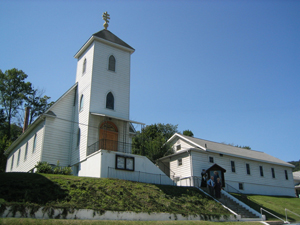 St. Mary’s Orthodox Church was incorporated in 1914 in Corning, NY. Building the present church commenced in 1916 and was completed in 1917. At that time it was a Greek Catholic Church, celebrating its Eastern Rite services and under the jurisdiction of the Pope of Rome. In the late 1930's, however, motivated by a variety of factors, St. Mary’s joined a group of other Greek Catholic Churches and formed a new diocese which returned to their ancestral Orthodox Faith under the jurisdiction of the Ecumenical Patriarch of Constantinople.
St. Mary’s Orthodox Church was incorporated in 1914 in Corning, NY. Building the present church commenced in 1916 and was completed in 1917. At that time it was a Greek Catholic Church, celebrating its Eastern Rite services and under the jurisdiction of the Pope of Rome. In the late 1930's, however, motivated by a variety of factors, St. Mary’s joined a group of other Greek Catholic Churches and formed a new diocese which returned to their ancestral Orthodox Faith under the jurisdiction of the Ecumenical Patriarch of Constantinople.
The diocese formed was and is The American Carpatho-Russian Orthodox Diocese of the U.S.A. The parish was founded by immigrants coming from the Carpatho-Russian Mountain regions of present day Slovakia and the Czech Republic. These Carpatho-Russian faithful began settling in the Corning area circa 1895-1900 coming mainly from the town of Stakcin in what was then Austria-Hungary. These people emigrated, like so many others, from their villages to better themselves economically and avail themselves of the political freedoms enjoyed in the United States. Besides finding employment, one of the first tasks of these immigrants was building a church in which they could worship and pass on their faith to their children. 1910 was a decisive year in the history of the parish. In that year numerous meetings of the church founders occurred in order to plan a church of their own in Corning. At that time services were held in St. Mary’s Roman Catholic Church hall whenever a Greek Catholic priest was available., but the faithful desired to have their own church. From that desire came sacrifice and a great deal of hard work (ditch digging and the like) to build St. Mary’s Orthodox Church.
Throughout the years, the parish purchased a home for its priests, built a church hall, and purchased a cemetery plot. Since their beginnings, the parish properties have undergone a variety of renovations.
Today, the parish faithful continue to profess their Orthodox Faith in a manner consistent with what has been given over to them from the Orthodox Church's 2000 year history. The faithful celebrate in worship and live out the faith communicated to them by generations of Orthodox faithful. St. Mary’s honors its past and continues to ask God to bless its efforts in the present day. It welcomes all who are seeking faith in God in an often troubling and doubt-producing time. The heritage of our church reveals a firm and fervent faith, and we invite you to visit us so that this faith might be yours as well.
